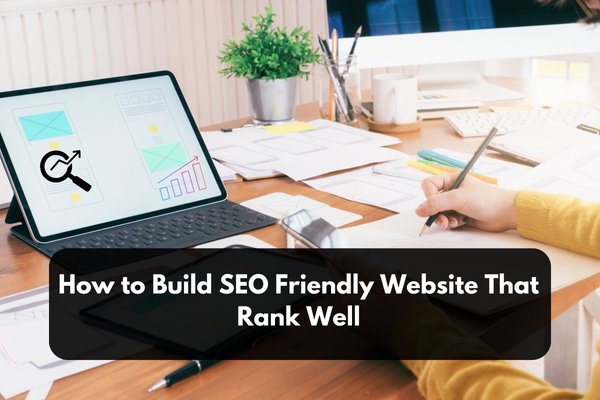In the vast and dynamic world of the internet, creating a website that stands out and ranks well on search engines is an intricate process that requires a strategic approach to Search Engine Optimization (SEO). In this comprehensive guide, we’ll delve deep into 15 essential tips that will empower you to build an SEO-friendly website capable of not only achieving high search engine rankings but also delivering an exceptional user experience.
Contents
- What is a SEO Friendly Website?
- How Do You Make Your Website SEO Friendly?
- Use Keywords Throughout Your Content
- Use Header Tags
- Include Keyword-Rich Anchor Text in Your Links
- Make Sure the Website Is Mobile-Friendly
- Have a Clean URL Structure
- Optimize Title Tags and Meta Descriptions
- Optimize Images
- Make Sure Your Web Pages Load Fast
- Use Images and Videos to Enhance Content
- Update Your Content Regularly
- Use Social Media to Promote Your Content
- Add Internal Links
What is a SEO Friendly Website?
An SEO-friendly website is crafted to enhance its visibility on search engine results pages (SERPs) by adhering to search engine guidelines and employing optimization strategies. This involves incorporating relevant keywords into well-structured content, ensuring a clean and efficient site architecture, optimizing for mobile responsiveness, maintaining fast loading times, and cultivating quality backlinks. By meeting these criteria, the website becomes more accessible and attractive to search engines, increasing the likelihood of being indexed and ranked higher. The ultimate goal is to drive organic traffic and improve the overall online presence of the site.
In essence, SEO-friendly websites prioritize elements that search engines value, aligning their design and content to rank favorably. This strategic approach not only caters to search algorithms but also enhances the user experience, creating a harmonious balance between optimization for search engines and delivering valuable content to the site’s visitors.
How Do You Make Your Website SEO Friendly?
Use Keywords Throughout Your Content
Keywords are the foundation of SEO. They act as the bridge between what users are searching for and the content you provide. Conduct thorough keyword research to identify relevant terms for your industry, and strategically incorporate them into your content. However, it’s crucial to maintain a natural flow; avoid keyword stuffing, as it can lead to penalties from search engines. The integration of keywords should be seamless and align with the context of your content. This strategic use of keywords helps search engines understand the relevance and subject matter of your pages, contributing to improved rankings.
Use Header Tags
Effective content structuring is not only beneficial for user experience but also plays a significant role in SEO. Header tags (H1, H2, H3, etc.) help organize your content hierarchically, providing both users and search engines with a clear roadmap of your page’s structure.Utilizing header tags appropriately improves content readability and allows search engines to comprehend the significance of different sections. This hierarchical structure aids in the proper indexing of your content, contributing to a more favorable position in search engine results.
Include Keyword-Rich Anchor Text in Your Links
Link building is a crucial component of SEO, and the anchor text you use within your links plays a pivotal role in how search engines interpret your content. When creating internal and external links, use anchor text that includes relevant keywords. This provides additional context to search engines about the content of the linked pages.
Strive for a natural distribution of anchor text and avoid over-optimization. The goal is to provide users and search engines with a clear understanding of the linked content’s context, contributing to a more robust SEO profile.
Make Sure the Website Is Mobile-Friendly
In an era dominated by mobile devices, having a mobile-friendly website is not just a recommendation but a necessity. Google and other search engines prioritize mobile-friendly websites in their rankings, as they recognize the growing prevalence of mobile users.Ensure your website is responsive, meaning it adapts seamlessly to various screen sizes. A mobile-friendly design not only improves SEO but also enhances user experience, contributing to higher engagement and lower bounce rates.
Have a Clean URL Structure
The URL structure of your website is a fundamental aspect of both user experience and SEO. Clean and concise URLs not only make it easier for users to understand the content they’ll find on a page but also assist search engines in comprehending the relevance of each URL.Avoid lengthy and cryptic URLs. Opt for short, descriptive URLs that convey the content’s subject matter. This not only enhances user navigation but also contributes to a positive SEO outcome.
Optimize Title Tags and Meta Descriptions
Crafting compelling title tags and meta descriptions is an art form in the realm of SEO. These elements serve as the first point of contact with potential visitors, influencing their decision to click through to your site. Ensure that title tags are concise, descriptive, and include relevant keywords.Meta descriptions, while not a direct ranking factor, can significantly impact click-through rates. Write engaging meta descriptions that provide a snapshot of what users can expect on the page, encouraging them to explore further. Optimizing these elements not only improves search engine rankings but also enhances the overall user experience.
Optimize Images
Visual content is a powerful tool for engaging users, but it’s essential to optimize images for both SEO and performance. Compress images to reduce page load times, a factor that directly influences search engine rankings. Use descriptive file names and include alt text to provide context to search engines and improve accessibility.Optimized images contribute to a faster, more efficient website, ensuring a positive user experience. Search engines recognize the importance of page speed, and websites that prioritize image optimization often receive preferential treatment in search rankings.
Make Sure Your Web Pages Load Fast
Page speed is a critical factor in SEO and user experience. Users expect web pages to load quickly, and search engines reward sites that deliver on this expectation. Optimize your website’s performance by minimizing code, leveraging browser caching, and utilizing a Content Delivery Network (CDN) to distribute assets efficiently.Google’s PageSpeed Insights and similar tools can provide valuable insights into areas for improvement. A fast-loading website not only improves search engine rankings but also reduces bounce rates and keeps users engaged.
Use Images and Videos to Enhance Content
Multimedia content, including images and videos, not only enriches your website but also contributes to SEO. Well-optimized images and videos enhance user engagement and dwell time, both of which are positive signals for search engines.Ensure that multimedia elements are relevant and add value to your content. Use descriptive file names, alt text, and captions to provide context to search engines. Video content, in particular, has become increasingly important in SEO, with platforms like YouTube serving as powerful search engines in their own right.
Update Your Content Regularly
Fresh and relevant content is a hallmark of a successful website. Regularly updating your content not only provides value to your audience but also signals to search engines that your site is active, authoritative, and committed to delivering timely information.Create a content calendar to schedule updates and additions. This could include new blog posts, product pages, or revisions to existing content. Regularly review and refresh outdated information to ensure that your website remains a valuable resource in your industry.
Use Social Media to Promote Your Content
Social media serves as a dynamic and influential channel that holds the potential to significantly influence your website’s SEO. While social signals may not directly impact rankings, the indirect advantages of a strong social media presence are noteworthy. Utilizing platforms such as Facebook, Twitter, Instagram, and LinkedIn to disseminate and promote your content can amplify your digital marketing strategies for business growth. By leveraging social media, you can expand your reach, direct traffic to your website, and stimulate social sharing. As your content garners more shares and discussions on these platforms, it increases the likelihood of gaining visibility and recognition from search engines, further enhancing your business growth initiatives.
Add Internal Links
Internal linking is a fundamental yet often underestimated aspect of SEO. By creating a network of internal links, you not only assist users in navigating your site but also distribute link equity throughout your domain. Linking relevant pages to each other establishes a hierarchy and reinforces the importance of specific content.Strategically incorporate internal links within your content, ensuring they are contextually relevant. This not only enhances user navigation but also aids search engines in understanding the structure and significance of your content.
In conclusion, mastering the art of building an SEO-friendly website is paramount for online success. By partnering with a web design company in Myrtle Beach that embraces user-centered design, responsive layouts, intuitive navigation, and consistent branding, you establish the groundwork for a website that not only captivates your audience but also seamlessly fulfills their needs.A well-optimized website not only attracts organic traffic but also ensures a positive user experience. Continual adaptation to evolving SEO trends and regular monitoring using tools like Google Analytics are essential for sustained success. By incorporating these tips into your web development strategy, you lay the foundation for a high-ranking, user-friendly online presence.










